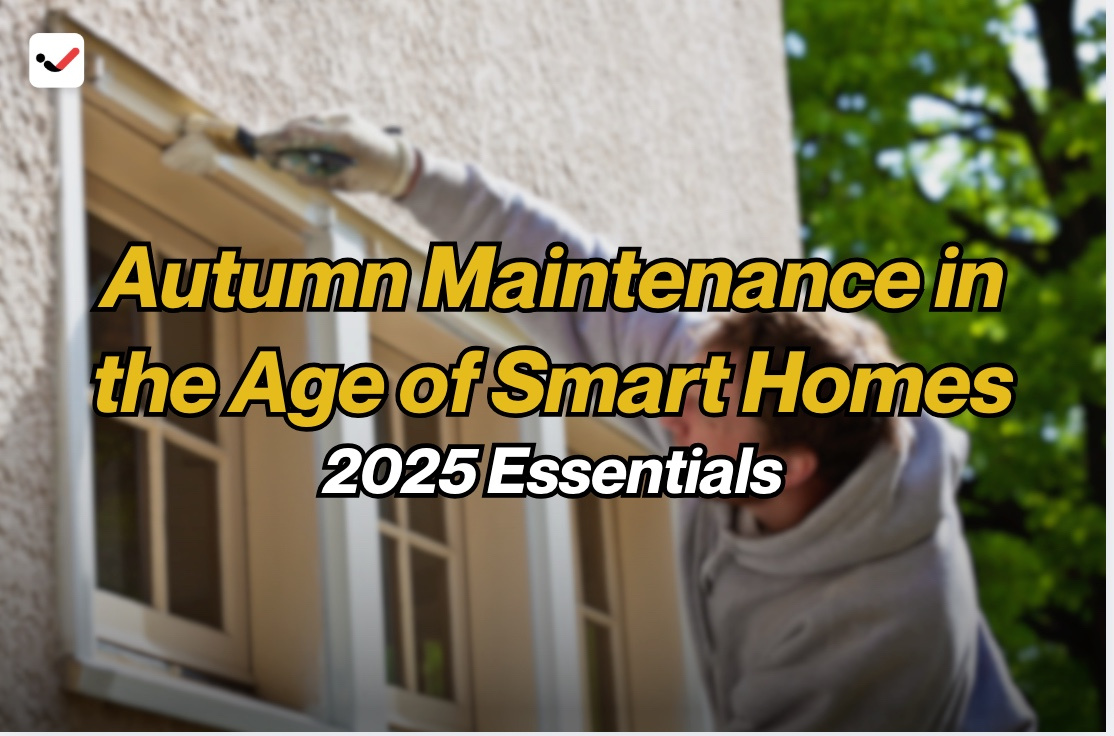Autumn Maintenance in the Age of Smart Homes: 2025 Essentials
Autumn Maintenance in the Age of Smart Homes: 2025 Essentials

Autumn brings shorter days, falling leaves, and cooler weather—signs it’s time to get your home ready for winter. In the past, this meant checking gutters, sealing windows, and servicing the furnace by hand. Today, the rise of smart home technology is changing how we take care of seasonal maintenance. Homeowners in 2025 have access to tools that make autumn preparation faster, easier, and more efficient.
From smart thermostats to automated leak detectors, modern devices can handle many tasks that once required manual effort. But smart homes still need some hands-on attention. Knowing which smart features to use and what traditional steps to take can save you money, energy, and stress. This guide covers the most important autumn maintenance tasks for connected homes in 2025, helping you stay warm and safe all season long.
1. Optimize Your Smart Thermostat for Cold Weather
A smart thermostat is one of the most useful tools for autumn maintenance. As temperatures drop, it adjusts your home's heating schedule based on your habits and weather conditions. In 2025, most smart thermostats also use AI to predict energy usage and suggest ways to save.
Make sure your smart thermostat is updated with the latest software. Clean the sensors and double-check the heating schedule to match your current routine. If your thermostat supports geofencing, turn it on—it will lower the heat when no one is home and warm the house before you return. These small actions can cut your heating costs and reduce your energy consumption.
2. Clean Smart Gutters and Install Leaf Sensors
Smart gutters are a newer upgrade in home maintenance tech. These systems monitor water flow and alert you when blockages occur. In autumn, falling leaves can quickly clog gutters, causing overflow and possible roof damage.
Install leaf sensors or use a smart camera to keep an eye on your gutters. Schedule a cleaning before the leaves pile up. Some smart gutter systems in 2025 even come with self-cleaning features or connect to your phone with real-time alerts. Keeping gutters clear prevents water damage, a major concern during the fall season.
3. Test Your Smart Smoke and Carbon Monoxide Detectors
Fire safety is a top priority in colder months. As people start using fireplaces, space heaters, and furnaces, the risk of fires and carbon monoxide leaks rises. Smart detectors can send alerts to your phone, even when you're away.
Make sure all smart smoke detectors and carbon monoxide detectors are working properly. Replace batteries if needed and test them using the app. Many new models in 2025 also monitor air quality and humidity, offering added protection. Having these devices in place keeps your home safer during the heating season.
4. Seal Drafts with Smart Window Sensors
Drafty windows and doors can raise your heating bill and make rooms uncomfortable. Use smart window sensors to check for air leaks. These sensors alert you if a window isn’t fully closed or if there’s unusual airflow.
Once you find a draft, seal it with weatherstripping or caulk. Some newer smart home hubs can even link with your heating system to adjust the temperature in drafty rooms automatically. Stopping air leaks is one of the simplest ways to improve home energy efficiency during fall.
5. Inspect and Prepare Your Smart Irrigation System
In colder areas, outdoor plumbing systems need to be winterized. If you have a smart sprinkler system, now is the time to shut it down for the season. Most systems in 2025 come with freeze sensors and seasonal settings.
Drain water from the system and turn off the supply line. Some smart irrigation systems offer step-by-step winterization instructions through the app. Skipping this step can lead to frozen pipes and costly repairs. Taking care of this now protects your lawn and your plumbing as temperatures fall.
6. Use Outdoor Smart Cameras and Lighting
With shorter daylight hours, outdoor smart lighting becomes more important. Smart lights with motion sensors can help prevent accidents and boost security. Pair these with smart security cameras to keep your property safe as nights grow longer.
Check all outdoor devices for proper operation. Clean the camera lenses and update firmware. You can also set schedules or automation rules to turn on lights at sunset. A well-lit home not only looks better but also deters unwanted visitors.
7. Monitor Indoor Humidity with Smart Sensors
As the air becomes drier in autumn, it’s important to keep an eye on your home’s humidity levels. Low humidity can cause dry skin, static electricity, and even damage wood furniture or floors. Smart humidity sensors and smart humidifiers make this easy to manage.
Most smart sensors in 2025 can be connected to a central hub or app. If the air gets too dry, the system can activate a humidifier automatically. Keeping indoor humidity between 30% and 50% helps maintain indoor air quality and comfort.
8. Perform a Smart Home System Checkup
Just like your HVAC system needs maintenance, your smart home system needs attention too. Take time this autumn to do a full smart home audit. Check that all devices are connected, powered, and updated.
Many smart home hubs now offer diagnostic tools that scan your network and suggest fixes. Review permissions and routines, especially those linked to seasonal triggers like temperature or daylight. An optimized smart home runs more smoothly and saves you time all winter.
9. Prepare Backup Power Options
Autumn storms and high winds can cause power outages. Smart homes rely on electricity, so having a backup plan is essential. Consider investing in a battery backup or home generator that integrates with your smart home system.
Modern options in 2025 can power your thermostat, security system, and essential lighting for several hours or more. Some systems automatically switch to backup mode when the power goes out. Don’t wait until you lose power—get your backup ready now.
10. Update Your Autumn Maintenance Checklist
Finally, update your autumn maintenance checklist to reflect your smart home setup. Make a list of tasks like updating firmware, checking sensors, cleaning devices, and testing automations.
You can even use a smart home app or voice assistant to remind you about regular tasks. Voice-controlled checklists are growing in popularity for home maintenance. Staying organized means you won’t miss any important steps as the weather changes.
Autumn in 2025 isn’t just about raking leaves and checking the furnace—it’s about using smart tools to maintain comfort, safety, and energy savings. Whether you’re sealing drafts, managing heating, or testing sensors, a connected home gives you more control than ever.
With the right mix of smart devices and seasonal awareness, you can protect your home, reduce energy waste, and enjoy the season worry-free. Smart autumn maintenance is no longer the future—it’s the standard.

